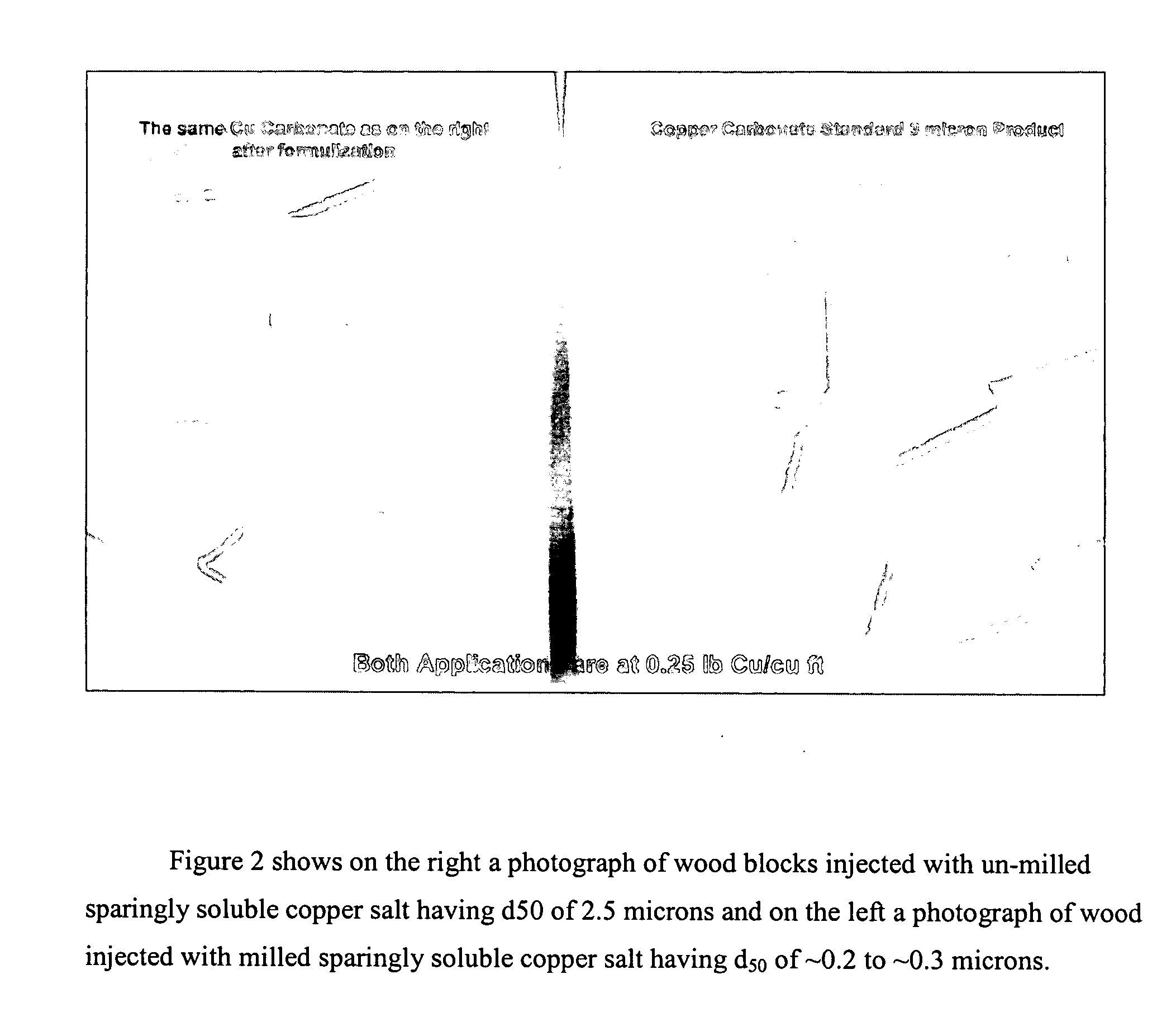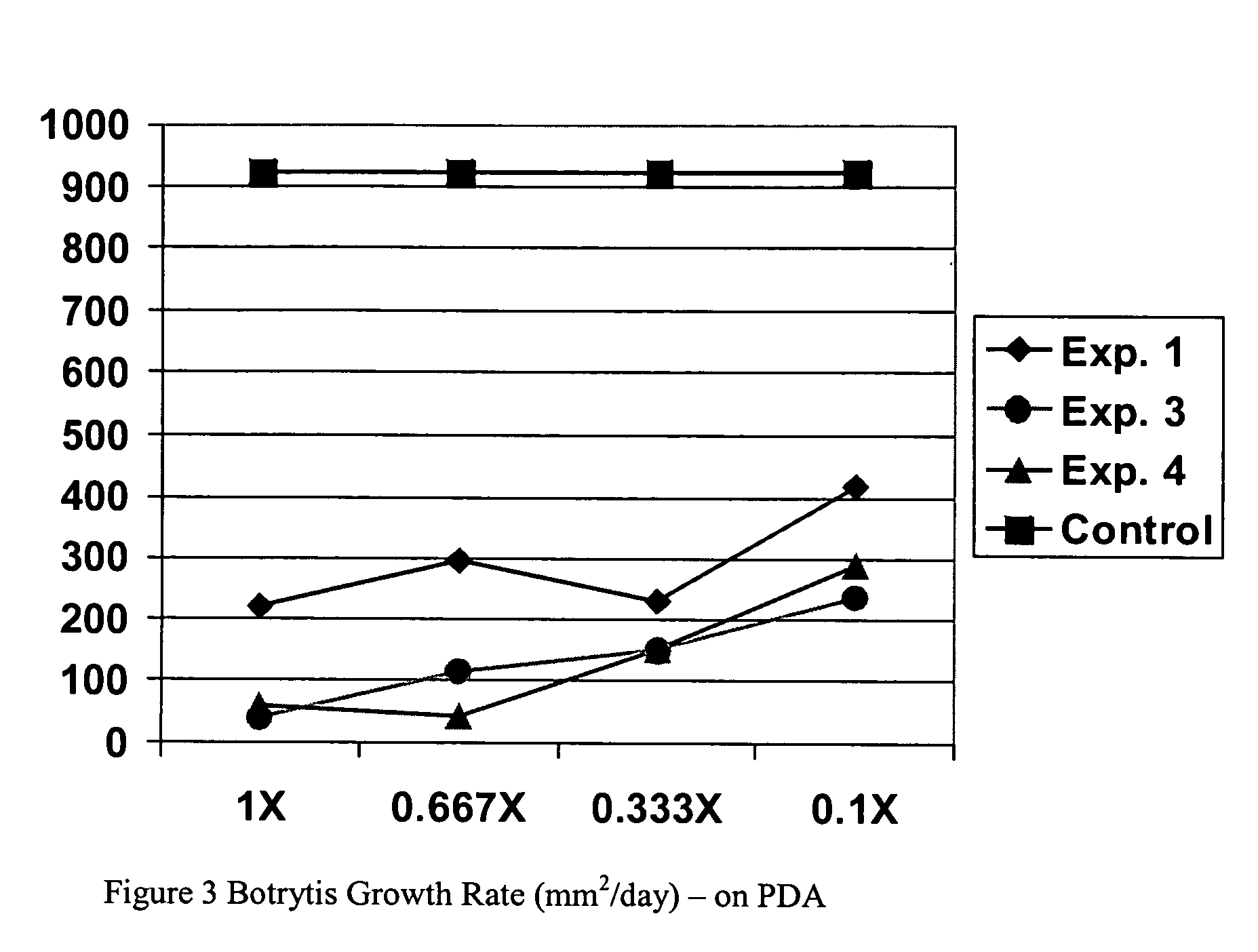Composition, method of making, and treatment of wood with an injectable wood preservative slurry having biocidal particles
a technology of biocidal particles and injectable wood preservatives, which is applied in the field of making, and treating wood with an injectable wood preservative slurry having biocidal particles, can solve the problems of amine/copper-containing wood preservatives, many times more leachable, and compromising the long-term efficacy, so as to reduce degradation
- Summary
- Abstract
- Description
- Claims
- Application Information
AI Technical Summary
Benefits of technology
Problems solved by technology
Method used
Image
Examples
example 2
[0232] Similar conditions were used in the experiments described in Example 2 as were used in comparative experiment 1. In this Example, the preferred organic biocides Chlorothalonil and Tebuconazole were milled. The milling media comprised cerium-doped zirconium oxide beads or yttrium-doped zirconium oxide beads, having a particle diameter of 0.4-0.5 mm or 0.3 mm. The density of the doped zirconium oxides is >6.0 g / cm3, compared to the ˜3.8 g / cm3 density of zirconium silicate beads used in comparative example 1. Additionally, the biocidal efficacy of milled chlorothalonil was compared to the biocidal efficacy of un-milled Chlorothalonil.
example 2-a
[0233] A first formulation, containing 20.4% chlorothalonil, 5% Galoryl™ DT- and 120 brand naphthalene sulfonate formaldehyde condensation product, 2% Morwet™ EFW, 3% Pluronic™ F-108 block copolymer (dispersant), and 69.2% water by weight, at a pH of about 7.3, was wet ball milled in a CB Mills, model# L-3-J mill with 0.4-0.5 mm doped zirconia. The total batch weight was about 600 g. The results are shown in Table 2 below.
TABLE 2Wet ball milling Chlorothalonil with 0.4-0.5 mm zirconiaParticle Size Data - Volume %Milling Timed50With Diameter Greater ThanMins.μm10 μm5 μm2 μm1 μm0.4 μm03.448307792——900.31333322—2400.210123351
[0234] The above-described composition does not have a particle size distribution which will result in a commercially acceptable injectable wood composition, even after 240 minutes of milling. The composition can be further treated with for example a centrifugal finishing technique which effectively removes all particles with an effective diameter greater than 2 ...
example 2-b
[0238] The next test was performed with a composition containing 20.8% tebuconazole, 3% Pluronic™ P-104 brand block copolymer, 1.5% Morwet™ D-425 brand naphthalene sulfonate, 0.1% Drewplus™ L-768 brand dimethylpolysiloxane (30%), and 74.6% water by weight. This composition was wet ball milled in a CB Mills Vertical Mill Model L-1 with 0.3 mm yttrium-doped zirconia. Prior to milling, the d50 of the tebuconazole was about 27 microns. The results are shown in Table 3 below.
TABLE 3Wet ball milling Tebuconazole with 0.3 mm zirconiaMilling TimeParticle Size Data - Volume % With DiameterMins.>50 μm25-50 μm10-25 μm1-10 μm0.2-1 μm026.627.242.24——150003.64.220.771.5
[0239] The above-described composition does not have a particle size distribution which will result in a commercially acceptable injectable wood composition. The composition can be further treated with for example a centrifugal finishing technique which effectively removes all particles with an effective diameter greater than 2 m...
PUM
| Property | Measurement | Unit |
|---|---|---|
| Length | aaaaa | aaaaa |
| Length | aaaaa | aaaaa |
| Fraction | aaaaa | aaaaa |
Abstract
Description
Claims
Application Information
 Login to View More
Login to View More - R&D
- Intellectual Property
- Life Sciences
- Materials
- Tech Scout
- Unparalleled Data Quality
- Higher Quality Content
- 60% Fewer Hallucinations
Browse by: Latest US Patents, China's latest patents, Technical Efficacy Thesaurus, Application Domain, Technology Topic, Popular Technical Reports.
© 2025 PatSnap. All rights reserved.Legal|Privacy policy|Modern Slavery Act Transparency Statement|Sitemap|About US| Contact US: help@patsnap.com



